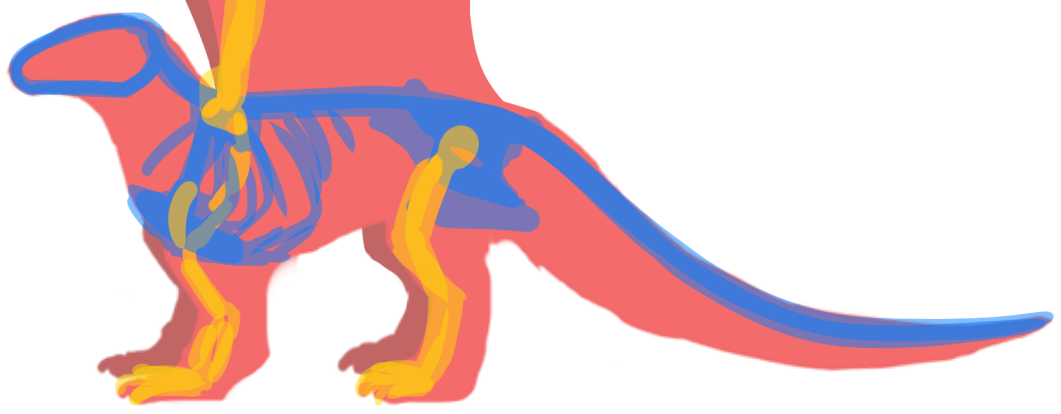True dragon
More commonly, and rather confusingly, known as dragons, true dragons are intelligent creatures found on all Itoran continents. Predatory carnivores, true dragons form the apex predators of all continents. The only areas of Itorah where they may fear predation is the ocean, where larger sea serpents could kill and consume them.
Basic Information
Anatomy
Though much variation is found within the species, all true dragons share the same underlying anatomy. They are quadrupedal, with an extra set of limbs in the form of wings, growing from the shoulders. Proportions and builds vary greatly, as do shape of wings and number of digits in wings, hands, and feet. Their forelimbs, typically known as hands, typically display well-developed fingers, allowing them to grab, but lack opposable thumb.
Shown above is a generic dragon with a rough display of its skeletal structure, its body in blue and its limbs in yellow. The wings are intentionally cropped out to the great variance in shape. Especially notable is their breastbone, with its keel, to which the wing muscles attach.
Genetics and Reproduction
True dragons reproduce via eggs, with a somewhat leathery shell. When they are first laid they are soft and fairly unrecognizable, but over the course of a few weeks they harden and begin displaying recognizable colors and markings. Using these, the eggs of various dragon breeds can be told apart.
Growth Rate & Stages
Young dragons hatch self-sufficient, and can fly almost immediately afterwards, once given a moment to clear their wings from the remains of their eggs. They grow steadily over the course of several years, though they reach mental maturity after a year or two at most, with smaller breeds maturing quicker. Likewise, lifespan varies among dragons (and draconic breeds), but almost all dragons live for more than a century, and many are capable of living for several.
Dietary Needs and Habits
They are predatory carnivores, and typically hunt large terrestrial prey, though they will also consume marine prey if the opportunity strikes.
Additional Information
Social Structure
Wild dragons maintain set territories, but lifestyles and behaviors vary per breed. Typically larger dragons are less social, but many dragons prefer to share territory with a mate, or even a larger group. Group structure varies, with some dragon breeds preferring sharing their territory only with other dragons of the same breed, while others will share it with any dragon except their own. Size may also impact this, with larger dragons becoming jealous or territorial only over dragons of similar size.
Genetic Ancestor(s)
Geographic Distribution
Related Myths




Comments